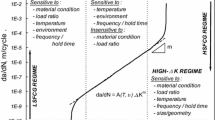Conclusions
-
1.
To calculate the long-term strength of parts used in power plants that are subject to brittle fracture under creep conditions it is necessary to use the proposed system of kinetic equations that reflect the effect of invariants of the stress tensor on the micromechanism of failure and the orientation of defectiveness.
-
2.
This system of equations can be most effectively used in the case of mixed fracture under conditions of creep where it is necessary to extrapolate the test results to operating times of more than 100,000 h and also for fluctuating force and temperature fields leading to a change in the mechanism of microfracture.
Similar content being viewed by others
Literature cited
Yu. N. Rabotnov, "Fracture due to creep," Zh. Prikl. Mekh. Tekh. Fiz., No. 2, 111 (1963).
C. M. Zener, Elasticity and Anelasticity of Metals, Univ. of Chicago Press (1948).
D. McLean, "Point defects and mechanical properties of metals and alloys at high temperatures," in: Vacancies and Other Point Defects in Metals and Alloys [in Russian], Metallurgiya, Moscow (1961), p. 197.
J. Intrater and E. Machlin, Acta Met.,7, No. 8, 140 (1959).
R. Gifkins, Acta Met.,4, 98 (1956).
D. Hull and D. Rimmer, Phil. Mag.,4 673 (1959).
G. W. Greenwood, Mater. Sci. Eng.,25, 241 (1976).
A. A. Vakulenko and L. M. Kachanov, "Continuum theory of substances with cracks," Izv. Akad. Nauk SSSR, Mekh. Tverd. Tela, No. 4, 159 (1971).
S. Morakami and N. Ono, "Theory of defectiveness of materials during creep under conditions of complex stress," in: Reports of the International Symposium on the Strength and Fracture of Materials and Structures at High Temperatures [in Russian], Moscow, September, 1979, Part 2, p. 36.
I. I. Trunin, "Resistance to long-term failure and some characteristics of deformation under complex stress conditions," Zh. Prikl. Mekh. Tekh. Fiz., No. 1, 110 (1963).
A. M. Lokoshchenko, V. A. Myakotin, and S. A. Shesterikov, "Creep and long-term strength of steel Kh18N10T under complex stress conditions," Izv. Akad. Nauk SSSR, Mekh. Tverd. Tela, No. 4, 87 (1979).
Additional information
Translated from Metallovedenie i Termicheskaya Obrabotka Metallov, No. 12, pp. 22–24, December, 1980
Rights and permissions
About this article
Cite this article
Petrenya, Y.K., Chizhik, A.A. Defects and long-term strength of materials with low deformability. Met Sci Heat Treat 22, 877–879 (1980). https://doi.org/10.1007/BF00779395
Issue Date:
DOI: https://doi.org/10.1007/BF00779395




